Tourists Must-See Attractions in Ho Chi Minh City (Part 1)
Today, Ho Chi Minh City is a popular tourist destination due to its fascinating culture, classic French architecture, and skyscrapers as well as ornate temples and pagodas. Here is the list of the famous attractions of this city that you cannot miss.
1. BEN THANH MARKET
Ben Thanh Market covers a large area, therefore, it is not easy to locate where you are at while inside the market, so avoiding going to the market in the rush hours (11.00 am to 13.00 pm or 16.00 pm to 18.00 pm) is highly advised, however going during the crowded hours doesn’t lower the excitement. In the evening, many larger food stalls will start opening in the surrounding area of the market, forming a very dynamic and energetic atmosphere with the dishes’ fragrance spreading across the street, including stir-fried noodles, grilled fish or pork, … Recognized as a witness of history through many decades, Ben Thanh Market has become one of the iconic symbol of Vietnamese culture.

If you are interested in trying the local’s street food menu, then arriving at Ben Thanh Market in the evening is the best time. Remember to empty your stomach before heading to the place, because you would not want to miss any dish. The domestic atmosphere, which the market generated, is incredible as you will be blending in with endless lines of locals coming here to enjoy the dishes after a long day working or studying.
If you are planning going to the market for shopping purpose, the ideal time is early in the morning when you may find discounted handmade wooden or bamboo crafts, accessories. The other accessories can be found here are clothes, silk, backpacks, suitcases, watches or electronic households. The attractive smell of spices, nuts and other fruits floating across the market will certainly make the place more appealing, along with the noises heard from the tourists’ conversations or the local people bargaining. Do not forget that many items’ prices are fixed, so only pay for what you want at a reasonable price.

Every single taxi driver would know the market’s location, as it is one of the most popular destination in Ho Chi Minh City. However, be sure to check the map and see if you can go to the market on foot from your current location, as the market is located in the center of the town and easily reached.
2. TURTLE LAKE
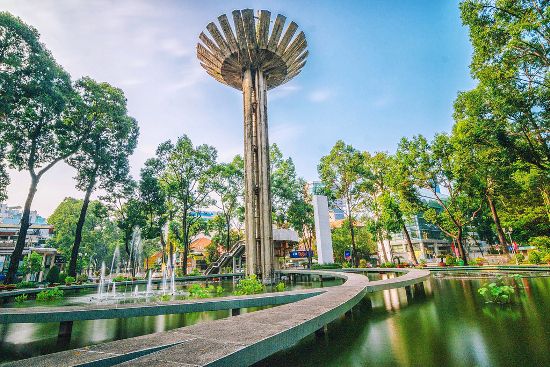
The lake was named Turtle Lake (or Ho Con Rua) because of a statue of a turtle was placed on the lake many years ago. The place had a strong connection with Dinh Doc Lap (the Independence Palace). Some people stated that president Nguyen Van Thieu himself had made the decision to build the lake back in 1967. As Nguyen Van Thieu was elected to the vacant President seat of Republic of Vietnam in southern Vietnam, he asked a Chinese man with expertise in Feng Shui (geomancy) to take a look at the Independence Palace and have a quick analysis. The experienced feng shui master then stated that the place was built on a “dragon current”, or as known as lung-mei. He also told the president that Independence Palace was placed directly on the dragon’s head and its tail lies at Cong Truong Chien Si, about 1 kilometer away from the Palace. That led to many people calling the Independence Palace under the name Phu Dau Rong (Dragon’s Head Palace). The Chinese expert had also informed Nguyen Van Thieu, that the dragon reflected the future of the Republic of Vietnam. The dragon was feeling asleep back then, but whenever it woke up and whipped its tail, Southern Vietnam’s governing body would falter. Therefore, President Nguyen Van Thieu had made the order to build an artificial lake, placing a statue of a turtle at the exact spot where he was told the tail of the dragon lied. Its purpose was to prevent the dragon from whipping its tail even when it came out of the sleep. Despite the efforts, Republic of Vietnam was eventually defeated and no longer exist nowadays.
The building of the lake was handled by Nguyen Ky – a quite popular architect during that time. The most impressive structure is the tower with five supporting pillars looking like five giant swords pinning down the ground. Some says it has more similarities to a huge blooming lotus, grows beyond the city. In front of the place is a fountain with four curved sprinklers running to the central area. There used to be a statue of a turtle made out of iron with its back carved from stones right in the central area of the lake. The turtle was destroyed later in 1978 by a group belonged to Socialist Republic of Vietnam, as it represented the remnants of an old empire. The lake covers a width of about 100 meters and ever since it was built, the place has always been one of the most attractive destination for travelers in both Saigon and Ho Chi Minh City. The place was largely untouched and remained the same, making it one of the iconic historical area in the South of Vietnam.
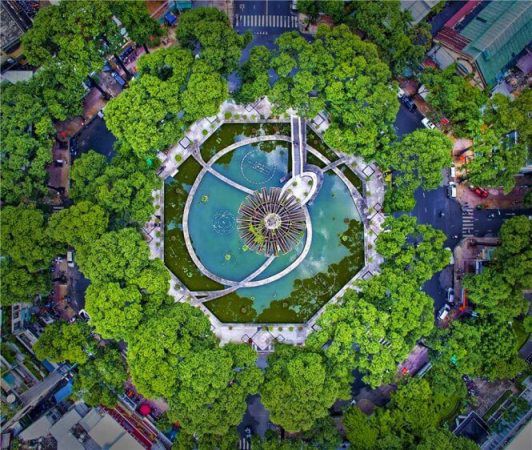
The lake only a few hundred meters away from the holy Notre Dame Cathedral and the beautiful Saigon Central Post Office, making it one of the best travelling spots in town, mainly due to its magnificent scenery, the tranquilizing surroundings and the fascinating street cuisine culture. A trip to Turtle Lake is absolutely worth your time, in order to truly learn its backstory as well as hanging out and chilling in a simple and easy way.
3. HO CHI MINH WAR REMNANTS MUSEUM

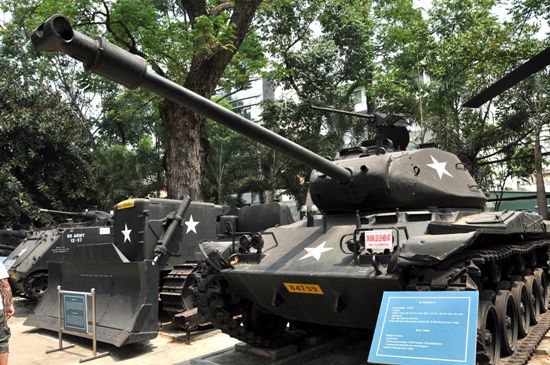
4. SAIGON CENTRAL POST OFFICE
The Saigon Central Post Office is located at 2nd Paris Commune Street, opposite to Notre Dame cathedral, represents the quality and spirits of 19th century western architectural designs.
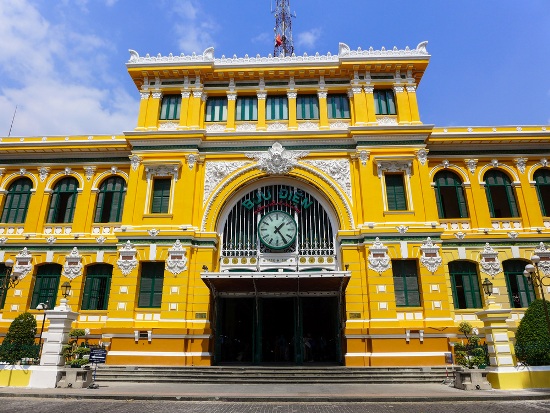
The identity of the engineer who designed the Post Office remains a mystery. Some believed that the one created the place was Gustave Eiffel, the same French architect that built the famous Eiffel Tower in Paris and the Statue of Liberty in New York. Other sources stated that the building was designed by an architect called Villedieu, along with his assistant Foulhoux. Some even complicated the story by noting that Eiffel was the first to design and built the place, Villedieu and Foulhoux only reconstructed it afterwards. Either way, French’s iconic architectural designs can be seen through the curved windows or the large clock hanging high above the main gate.
The windows on both sides of the Post Office are curved. However, the main hall only consists windows with rectangular shapes. The decorations around the windows remind people of those beautiful train stations in Europe. The two rows of pillars standing on the front hall of the building were taken care of with artistic decorations. The main pillars with the task of supporting the second floor are specially beautified with rectangular stones, carved in the names of the scientists who had a major impact to the development of mankind such as Thomas Alva Edison, Albert Einstein, Alexander Graham Bell, …
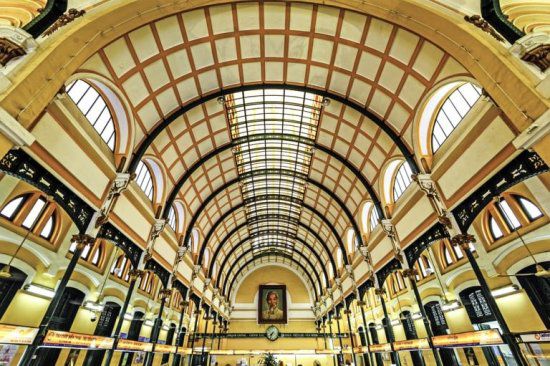
All paintings here are original, with other accessories such as the vintage telephone booths, glue pots for sticking stamps and letter writing tables remain untouched, it is evident that time has no effect on this beautiful post office.
5. SAIGON OPERA HOUSE
Saigon Opera House shows the magnificence of 19th century western architectural culture, being built with full supervisor from the French architect Eugene Ferret in 1897 under the name of Opėra de Saigon. Starting from early 1956, it was used by the State of Vietnam (later changed to Republic of Vietnam) as a Lower House. The complex then has gone through a few reconstructions and nowadays, the theater only open during special events.
Between World War I and World War II, all costs of mobilization and demobilization as well as other costs for the theatre companies from France to Saigon were paid by the municipal government. Despite the fact that the theatre was planned as an entertainment venue for the growing middle class. Its audience declined as more and more night clubs and dance halls boomed in the city. During this period, performances were presented only occasionally, some being concerts and other Cai Luong programs.
In 1955, the theatre was restored as the seat of the Lower House of the State of Vietnam, then the Republic of Vietnam. After the Fall of Saigon in 1975, the building was restored to its original function as a theatre. In 1998, on the occasion of 300th anniversary of the founding of Saigon, the municipal government had the theatre façade restored.
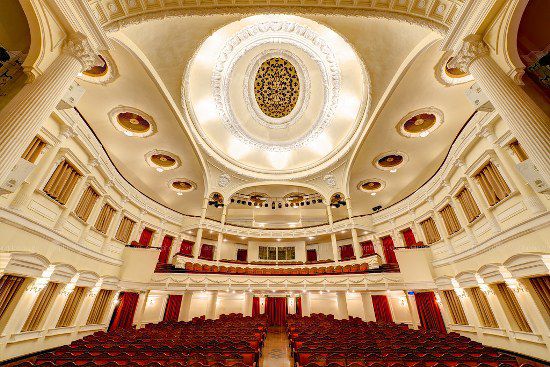
Saigon Opera House only opens to the people when events being commenced here. Therefore, guests only have to pay for the tickets in order to discover the place, there is no extra payments whatsoever. The amount of money you have to pay for the show depends on which time the events are thrown, the size of the events and which seat you want to take.
6. WATCHING WATER PUPPET SHOWS IN HO CHI MINH CITY
The shows are only performed in Vietnamese, however, this does not affect the experiences of the foreign attendances because of the lively and entertaining body language of the puppets is more than good enough for the audiences to keep up with the story. Musicians will play their instruments in the background to provide some sound effects or songs, meanwhile puppets in various forms like normal people, dragons, fairies, … telling the stories on stage.
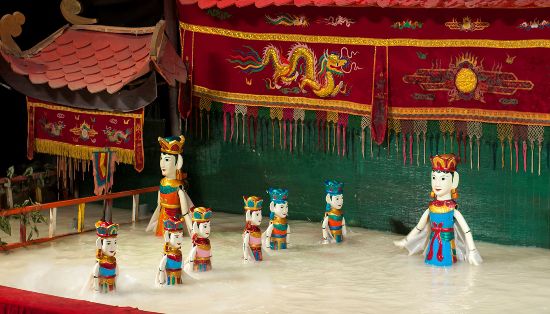
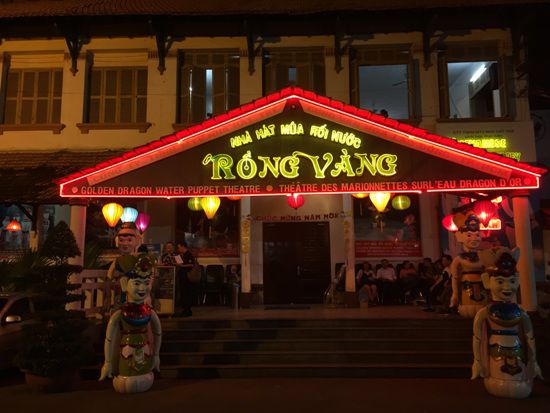
7. VIETNAMESE TRADITIONAL MEDICINE MUSEUM
Vietnamese traditional Medicine Museum is also called the FITO Museum, since it was constructed and now under the management of Fito Pharmacy Company Ltd. The museum comprises an acreage of 600 square meters, includes five floors with about 24 rooms in total, in which there are 16 rooms are now being used for exhibition purpose. There is a shrine placed on the highest floor, used to honor the two people who were recognized as the ones who invented Vietnamese traditional medication, one is Tue Tinh (born in 1330 and deceased around the 1400s), the other one is Le Huu Trac, or goes by the name Hai Thuong Lan Ong (1720-1791). The shrine made of wooden boards lying flat with parallel sentences carved on, painted with a red layer and decorated with gold – a really special way to honor the two healers and show how important they were to traditional medicine development. Visitors can also see the instructions on how to make the Vietnamese traditional medicine, step by step, by reading them on carved wooden walls and pillars inside the museum.
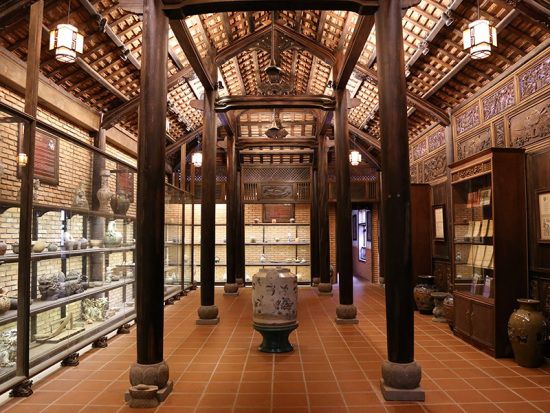
There are two special sections named “Northern traditional medicine house” and “Southern traditional medicine house”, which were rebuilt and now are displaying a variety of priceless pharmaceutical. Tourists can try to be a healer by wearing the traditional healer’s suit, try making drugs with the tools and herbs provided, learn to feel a person’s pulse and predict whether he (or she) is sick or not. You can truly understand more the use of different medicine processing tools, for example pestles and mortars, the scales to measure medicines, various kinds of herbs and plants are used to make the cure and the medicine cooker, along with drawers which are used to contain the herbs.
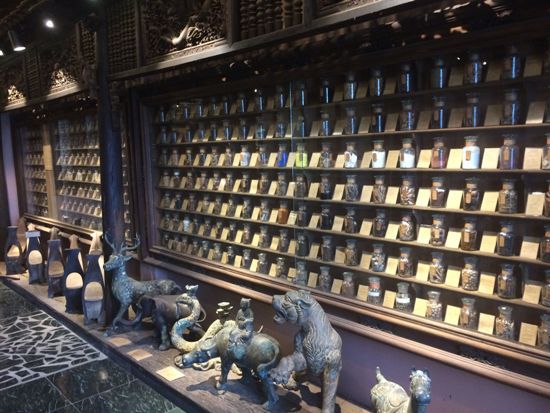
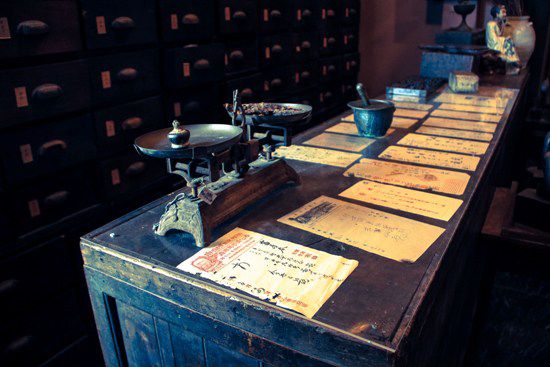
There is also a bookshelf displaying many medical books and notes, mostly written in Chinese and “chu Nom” (ancient language of Vietnamese), explaining the use of many traditional medicines, undeniably a priceless gift that the ancestors have left behind.
An American visitor, named Anna, has shared her thoughts: “The items displayed here are truly amazing and one of a kind, they truly enlightened us about the long-lasting history of Vietnam’s medication treatment.
Free herbal tea is served to the tourists before they end their trip into the museum. The quality of the tea was so great that it surely has a big positive impact on the visitors’ experience.
Note when walking around
- Walking in Saigon on sunny days is one of the interesting experiences that tourists cannot miss. However, during these street walks, you should still have some small notes, such as choosing to walk on the open streets, less smoke.
- A common problem in the city is robbery, especially small bags, phones or jewelry. To ensure the safety of both people and belongings, you should be careful when walking, avoid exposing expensive jewelry or phones and always taking precautions.
related destinations
(+84) 3 87 86 68 52
Testimonials
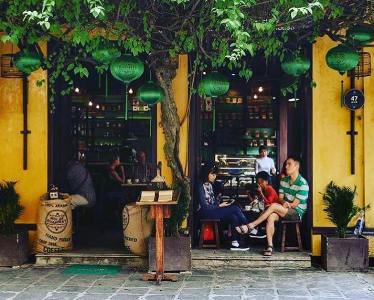
Excellent arrange, a really adapted proposal to our request
We were a group of 3 couples, chose FarEastour for our trip in Vietnam. We had some wishes:...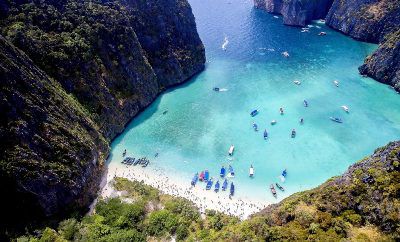
Highly recommended travel agency
We are very happy with our 22 days trip organized by Far East Tour! Our travel consultant,...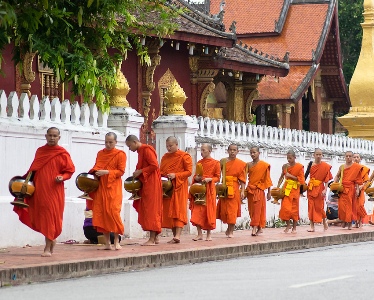
Dear Esther, I had a great time in Asia! You did arrange everything so perfect. Thank you so...

Touch with you again and remembering our unforgettable trip
Dear Christine, Hello, is good getting in touch with you again and remembering our unforgettable...
We had a very pleasant tour on Douce Mekong
Dear Wind, Thank you once again for your assistance, we had a very pleasant tour on Douce...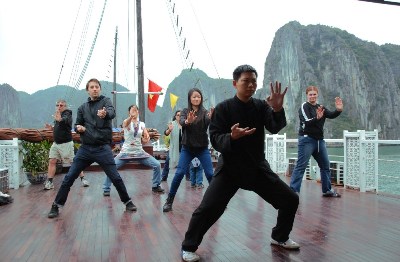
The trip to Ha Long Bay exceeded my expectations
Morning Esther, Now that I have returned to Australia I just wanted to send you a quick...
My trip to Sapa with your company has been great
Thanks a lot for your collaboration. About my trip to Sapa with your company has been great. The...
13 Days From Hanoi to Mekong with lots of happiness
We have been very happy having Mr Cong as a guide for Hanoi, and our cruise in Halong Bay was...
We asked Far East to put together a tour of Vietnam from north to south. They promptly emailed a...

Very professional and experienced travel agent
Very friendly and professional travel agent. Good advice given on what type of journey suits you....
I recommended your company to our travel agent in Germany
Dear Christine, Everything was fine, also the food. And for the vegetarian they tried special... Vietnam Tours
Vietnam Tours Vietnam Touren
Vietnam Touren Voyage au Vietnam
Voyage au Vietnam 越南旅游
越南旅游 越南旅遊
越南旅遊
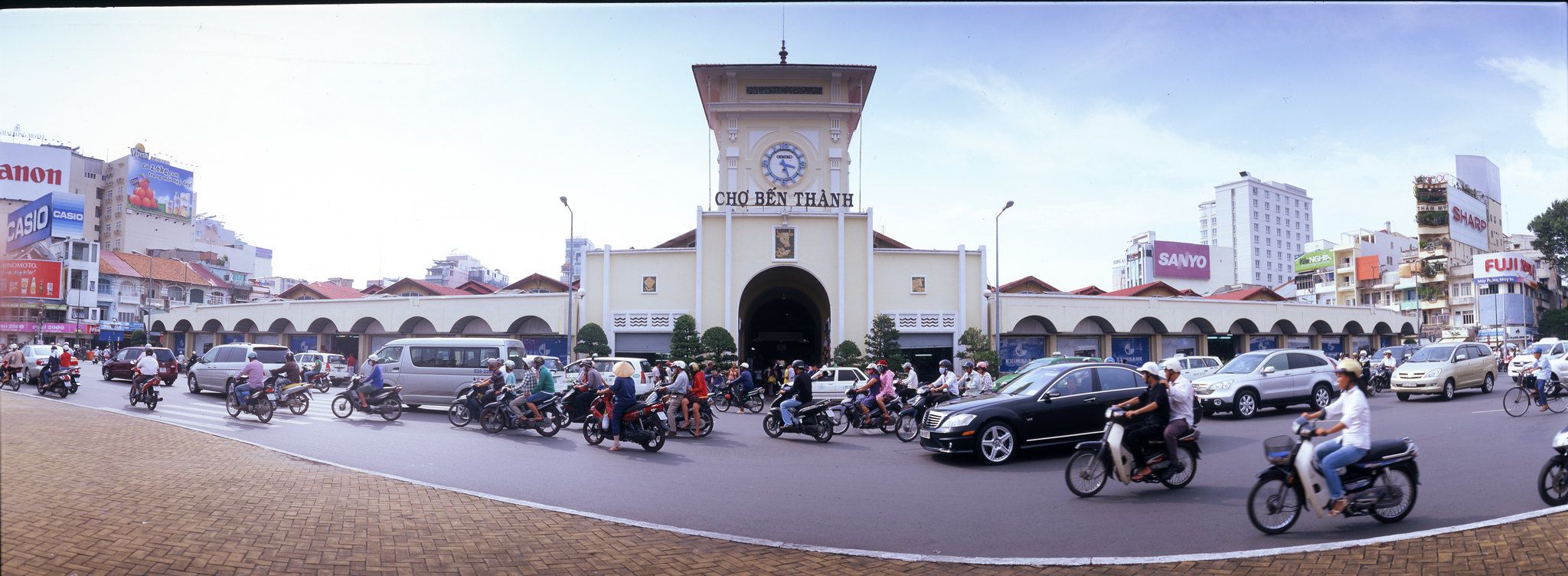


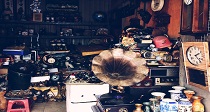
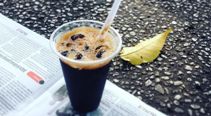



24/7